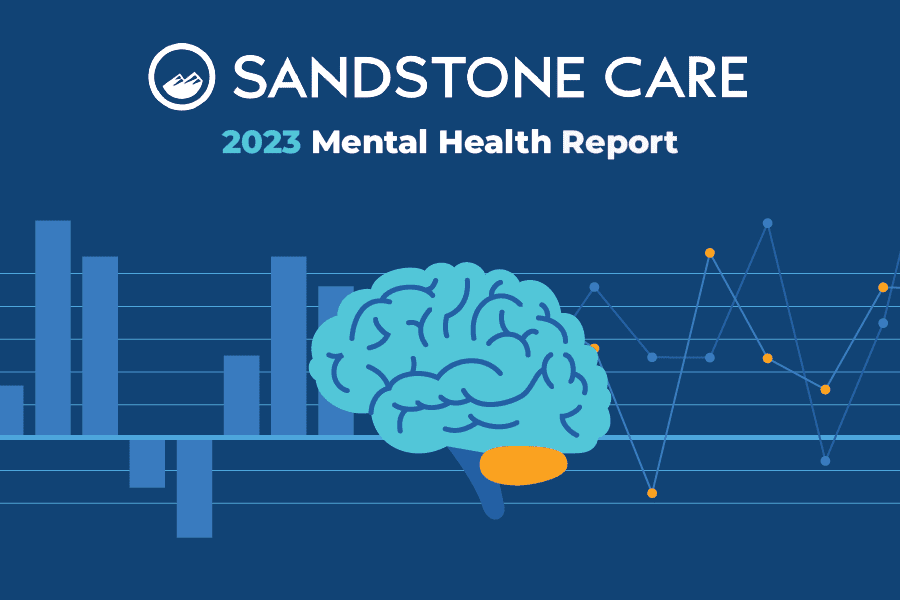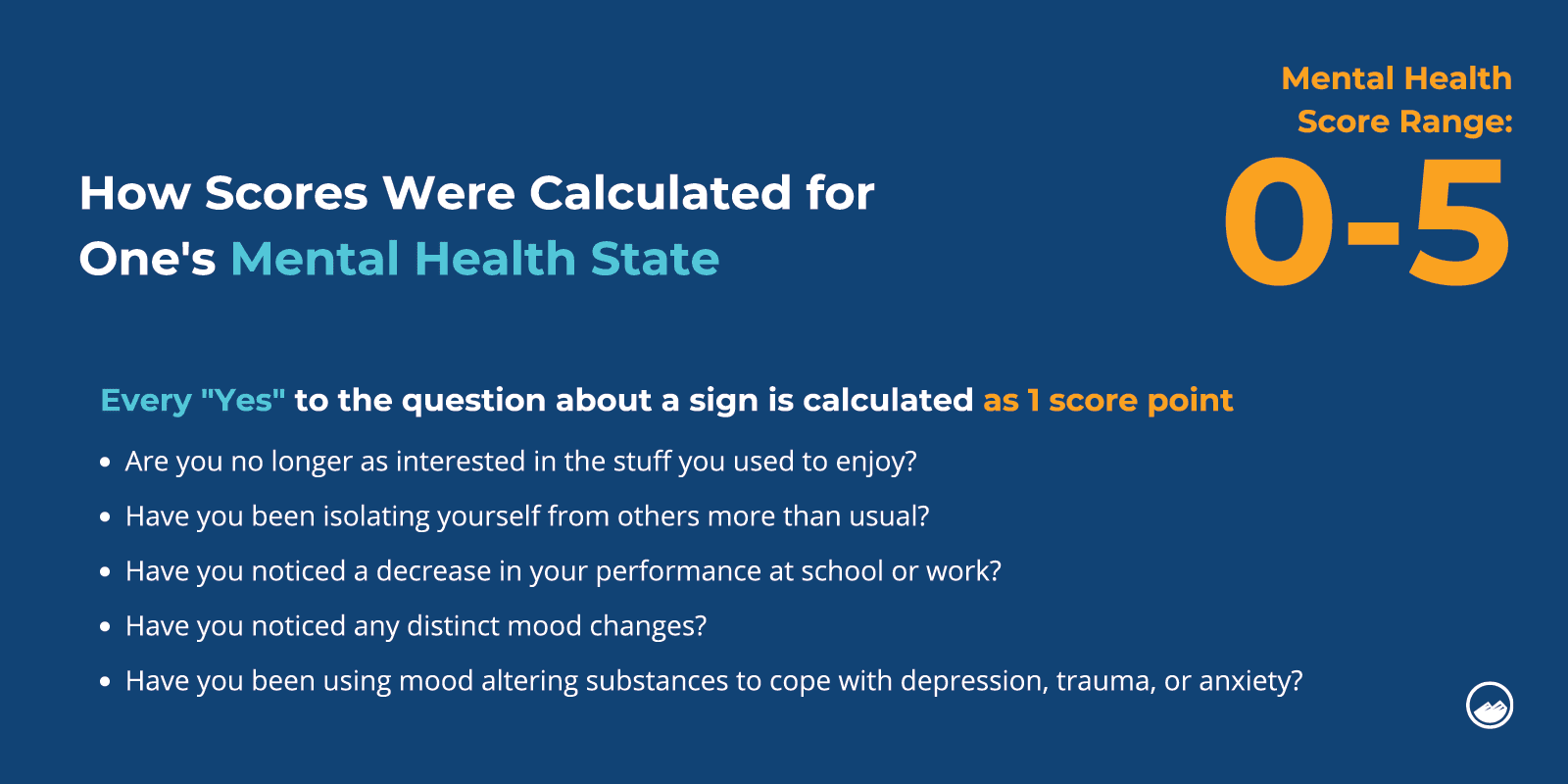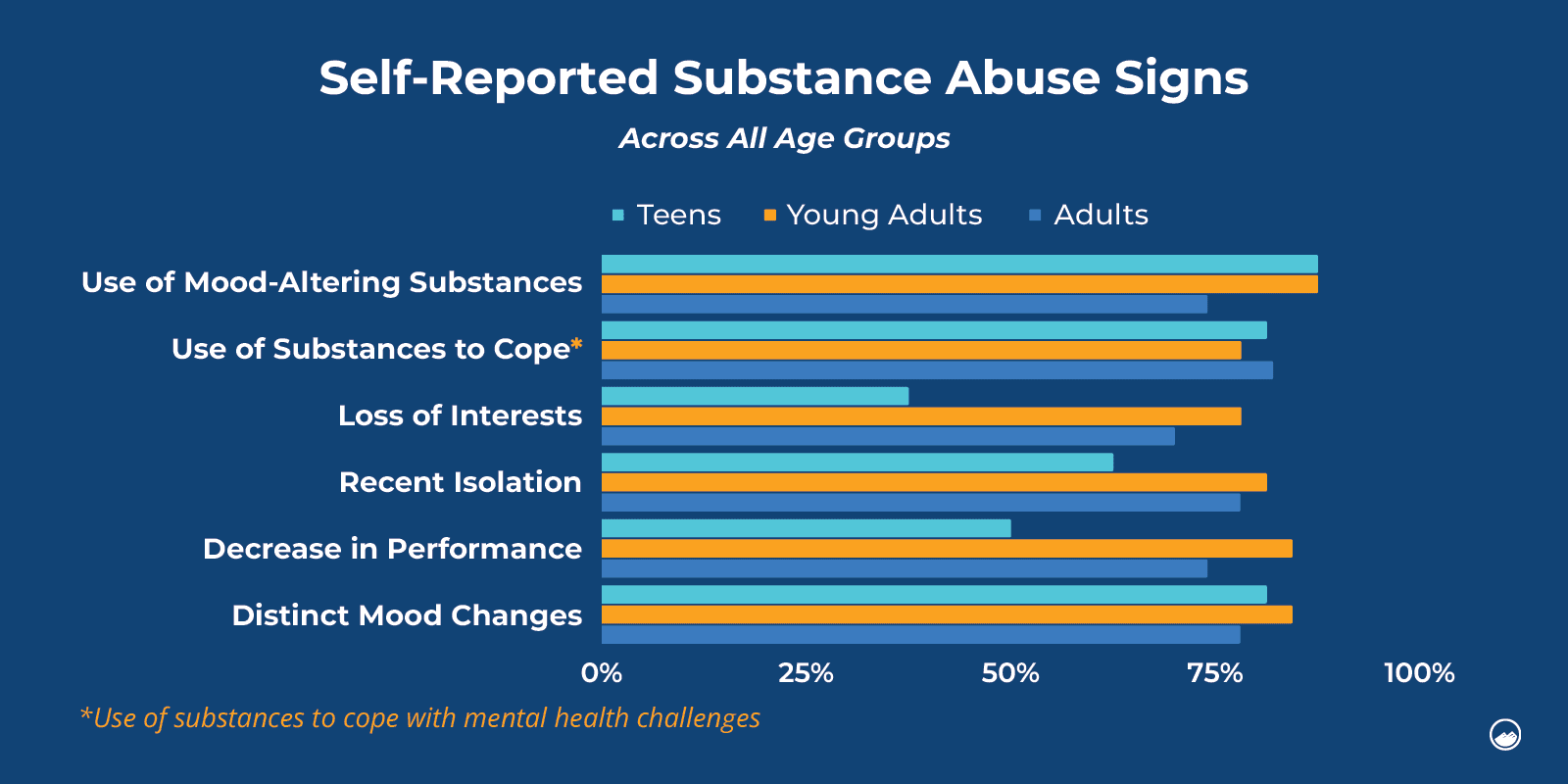Mental Health Statistics 2023


Each year brings new societal, economic, and personal challenges that can impact our ability to have healthy lives. Keeping a close eye on mental health trends gives us the opportunity to be prepared for the future and get ahead of growing crises. It is essential for mental health professionals, journalists, and American citizens to have access to the latest information on emerging trends in order to be empowered to make decisions that promote the well-being of our community.
By combining the results of Sandstone’s own original research with the latest findings from medical associations across the United States, this report provides unique insights into the mental health landscape in 2023.
Sandstone Care’s 2023 research project was conducted through an online survey that focused on assessing symptoms of mental health and substance use. Questions about mental health concerns centered on subjects like isolation, loss of interest, and mood changes. Participants had the option to fill out the survey as a self-report, or on behalf of a loved one.*
*Responses were tracked and separated into self-reports and loved-one reports
The survey was designed to assess mental health struggles by using a five-point scale. The scale ranged from least concern (one) to most concern (five).
Sandstone’s clinical team suggests that answering “yes” to 2 or more of the 5 questions below suggests the need for considering treatment options.
Our research focuses on the personal observations of participants, which allows unique insights into the mental health needs of our community. While intake statistics and hospitalizations provide essential information, those numbers are limited to identifying severe cases.
By allowing participants to provide responses about the social and emotional changes that they have observed in themselves or in their loved ones, Sandstone’s research is able to collect results from across the spectrum of mental health experiences.

Our survey found that mood changes were the most commonly reported symptom among teenage respondents. This finding aligns with the NIMH’s findings on the prevalence of mood disorders among teenagers.
Isolation was the second most common symptom reported by teenagers. Sandstone’s findings align with existing research that indicates that teenagers experience higher rates of depression and anxiety, which can be related to social rejection and feelings of loneliness.
Sandstone’s research also found that teens were quicker to take the mental health quiz than adults, with an average score of 3.46 when taken alone and 3.79 when taken by a parent or loved one. This suggests that teens may be more willing to assess their mental health problems before they become severe compared to other age groups.
Finally, Sandstone’s research found that parents or loved ones of teens typically observe distinct mood changes, loss of interest, recent isolation, and a decrease in school/work performance equally.

When teenagers enter into adolescence, they are hurled into a period of drastic transition and self-discovery that involves a great deal of change. Adolescents often face social, emotional, and physical challenges as they navigate their way from childhood to adulthood.
Teens may struggle with issues such as identity formation, peer pressure, and feeling misunderstood, all of which can impact their mental health. According to the World Health Organization, teens have high rates of depression, anxiety, and behavioral disorders.
Additionally, research by the National Institute of Mental Health (NIMH) has found that nearly 50% of adolescents in the United States have experienced a mental disorder at some point in their lives.
There are several factors that are unique to teenagers beyond their physical and cognitive development. For example, some research indicates a link between social media use and mental health crises in young people.
Current research suggests that mental health in teenagers is a point of concern for public health. According to the Centers for Disease Control and Prevention (CDC), suicide is currently the fourth leading cause of death for American teens from 12-19 years old.
Young adulthood is a stage of life marked by significant transitions and new responsibilities, such as starting a career, building relationships, and becoming financially independent. These changes can be exciting, but they can also stressful and overwhelming.
Young adults may face challenges such as balancing work and personal life, coping with financial pressures, and adjusting to new living situations, all of which can impact their mental health.
Additionally, young adults may also experience social isolation and loneliness as they move into the adult world for the first time, which can lead to mental health problems such as depression and anxiety.
Sandstone’s research found that young adults face significant mental health challenges. Distinct mood changes, recent isolation, and loss of interest were the three most commonly observed symptoms among young adults.
A startling 50% of young adults ranked at a severity level of 5, which indicates the highest risk of severe mental illness. These numbers held true for both self-reported responses and responses completed by loved ones. These rankings were the highest among all age groups surveyed.
Additionally, 88.57% of young adults showed 3 or more signs out of 5 when self-reporting. This insight shows that the vast majority of young adult participants were well above the treatment threshold.
Our research found that self-reporting young adults showed the highest level of substance use to cope with mental struggles out of all age groups. This finding aligns with risk factors for young adults and addiction disorders.
Sandstone also conducted a related survey centered exclusively on substance use that found similar results. It was conducted on a severity scale of one to six. Young adults evaluated themselves with the highest amount of substance use issues at 4.97 out of 6.
Parents or loved ones of young adults were more likely to observe the use of mood-altering substances among all groups surveyed. This finding is particularly concerning, as substance abuse is closely linked to mental health conditions.
The use of drugs or alcohol can exacerbate existing mental health issues, leading to a worsening of symptoms and a higher risk of suicide. Conversely, mental health conditions can increase the risk of substance abuse as individuals turn to drugs or alcohol as a means of coping with their symptoms.
Understanding this link between substance abuse and mental health is crucial for mental health professionals to provide effective treatment for those struggling with mental health issues and addiction. By addressing both issues simultaneously through dual-diagnosis programs, patients have a better chance of achieving long-term recovery.

For many adults, the demands of work, family, and other responsibilities can be overwhelming. The obstacles and daily challenges of adult life can lead to stress, anxiety, and burnout.
As adults age, they may also face additional challenges such as chronic health conditions, financial stressors, and changes in their social support network, which can further impact their mental health.
Our results verify the findings of NAMI, NIMH, and the WHO, indicating that mental health issues are prevalent among adults. Less than 15% of adults ranked below 3 on the five-point severity scale.
Among the symptoms reported, mood changes were reported most frequently, followed by isolation and performance issues. 34% of adults reported experiencing all signs, including substance use.
In the case of adults, the survey was almost entirely self-reported. By looking at the trends we found in other age groups, we can see that self-reported scores were consistently lower than those that were filled out by loved ones.
It is possible that the high amount of self-reporting in the adult survey could cause results to be underestimating the actual prevalence of mental health issues in the adult population.
It is important to consider the potential underreporting of mental health issues among adults and to encourage loved ones and mental health professionals to be vigilant in identifying and addressing symptoms of mental illness in this population.
Mental health issues are incredibly common among American adults, with 1 in 5 adults experiencing mental health illnesses each year, according to the National Alliance on Mental Illness (NAMI).
The most common mental health disorders among adults are depression, anxiety, and post-traumatic stress disorder (PTSD).
However, severe mental illnesses are also prevalent among American adults. According to the Centers for Disease Control and Prevention (CDC), about 1 in 25 U.S. adults lives with a serious mental illness, such as schizophrenia, bipolar disorder, or major depression. These conditions require ongoing treatment and support to manage symptoms effectively.
Unfortunately, stigmas surrounding mental illness can sometimes influence people to delay seeking care, which can worsen mental illness. The stigmas of previous generations may perpetuate viewing mental illness as a sign of weakness or a personal failing, leading to feelings of shame and reluctance to seek help.
As a result, many older adults may suffer in silence or try to cope with their symptoms alone, which can lead to further deterioration of their mental health.
Each stage of our lives is marked by distinct challenges and circumstances. For instance, while adolescents may struggle with identity and self-esteem issues, adults may face stress related to career and family responsibilities. These inevitable “growing pains” impact our mental health in unique ways that require targeted care.
Understanding how mental health issues can shift between age demographics is crucial in providing the best possible treatment and the most accurate reporting. When mental health care providers are equipped with the latest age-based research, they can tailor their treatment approaches to best meet the needs of each age group.
We are pleased to report that Sandstone’s research received a strong response from teens, young adults, and adults, with roughly equal participation across all three age groups.
This diversity of responses ensures that our research provides important insights into the mental health trends and challenges that impact each age group.
Mental health problems are struggles that affect an individual’s emotional, psychological, and social well-being. Some common mental health problems that many people experience are:
When mental health problems begin to significantly impact someone’s ability to function in their daily life, it is possible that those problems have evolved into mental disorders. Mental disorders and mental illnesses disrupt social, work, and personal lives over a prolonged period of time.
Examples of mental health disorders include ADHD, obsessive-compulsive disorder, post-traumatic stress disorder, schizophrenia, anxiety disorders, and depressive disorder. Serious mental illnesses such as schizophrenia or bipolar disorder can be debilitating and require ongoing treatment to manage symptoms.
If left untreated, mental health disorders can lead to a range of negative outcomes, including suicidal ideation, self-harm, and substance abuse. Early detection, diagnosis, and treatment of mental health problems are essential to minimize their impact on an individual’s life and prevent them from becoming more severe disorders.
Research, such as this annual report, can provide crucial information to both participants and readers that helps in the early detection of mental health disorders.

Substance use disorder (SUD) is a chronic and often relapsing condition that affects a significant portion of the population in the United States.
According to the Substance Abuse and Mental Health Services Administration (SAMHSA), around 19.7 million adults experience substance use disorder, many of whom begin substance use as adolescents and young adults.
Substance abuse can have serious mental health consequences. It is often linked to the development and exacerbation of mental health disorders. Drugs or alcohol may be used by those struggling with mental illness as a form of self-medication.
This creates a refeeding cycle of substance dependency and the emergence of new mental disorders which can be very difficult to escape, especially without professional treatment.
It is essential to recognize that treating substance use disorders involves addressing the underlying mental health conditions as well.
Sandstone’s findings on substance use revealed that these three symptoms were observed equally in all three age groups:
Each of the three age groups most frequently observed all symptoms of substance use problems, which indicates that substance abuse is a problem that affects people of all ages.
However, Sandstone’s research also found that loved ones of people struggling with substance abuse were more likely to observe the use of mood-altering substances. Since substance use and mental health struggles are still often stigmatized, this highlights the importance of involving family and loved ones in the recovery process.

Among the teens who reported using altering substances in Sandstone’s survey, over 65% of them revealed experiencing all of the mental health struggles that the survey mentioned. This highlights the alarming connection between substance use and underlying mental health issues among teenagers.
Parents play a critical role in identifying signs of substance use issues in their teens and determining if they need to seek care. Reports completed by parents of teenagers scored high on the severity scale, averaging 5.35 out of 6.
However, it’s worth noting that while substance use was significant, other symptoms such as isolation and mood changes were more prevalent across the board, indicating the complex interplay between mental health and substance use among youth.
Sandstone’s findings align with the recommendations of NAMI and the WHO, highlighting that substance use may be a common strategy employed by young adults in an attempt to manage their mental health struggles.
Notably, self-reported young adult responses highlighted the highest occurrence of using substances to cope with mental health struggles compared to other age groups.
The link between substance abuse and mental health conditions, commonly referred to as dual diagnosis, is a significant area of concern. It is important for mental health providers to recognize the interconnected nature of these challenges. Dual diagnosis requires specialized treatment approaches to foster comprehensive recovery.
In 2020, the COVID-19 pandemic upended the international healthcare landscape. Beyond its obvious physical devastation, the coronavirus pandemic also triggered a slew of mental health emergencies across the globe.
As it flooded hospitals with physical ailments, the pandemic also intensified pre-existing mental health risks and triggered new conditions. In the first year of the pandemic, the World Health Organization (WHO) reported a significant 25% increase in depression and anxiety cases worldwide.
Furthermore, the National Institutes of Health (NIH) has uncovered evidence suggesting that individuals with pre-existing mental health issues are at a higher risk of hospitalization from COVID-19. These disparities highlight the interplay between mental health and physical health outcomes during the pandemic.
In addition to the direct links between mental health issues and the COVID-19 pandemic, researchers also anticipate a surge in substance abuse. The link between stress, isolation, and substance use underscores the importance of addressing these issues together.
Isolation and circumstance-based fear both put people at risk of developing long-term mental health complications, and both have been rampant during the pandemic era.
Sandstone’s research found that these two factors were ranked as primary concerns in 2023. Isolation, fear, and uncertainty were observed by an overwhelming majority of Sandstone’s participants.
As we navigate the changing environment of 2023, with pandemic restrictions lifting and a return to normalcy, individuals are faced with the task of addressing the emotional devastation left behind by the pandemic era. Uncertainty in various domains, including personal, political, and economic aspects, continues to be a significant stressor, further impacting mental well-being.
There is good news, the CDC has observed a decline in emergency mental health visits among teenagers and young adults over the last year related to thoughts of suicide. These visits have declined 11% from their rates at the height of the pandemic.
However, public health organizations emphasize that mental emergencies among young people still constitute a major public health crisis.
This past year, marked by the gradual restoration of normal life, has slowly unfolded new health trends. While progress is being made, it is essential to recognize that the mental health challenges stemming from the isolation and disruption caused by the pandemic still linger, and that they still require ongoing attention and support.

Accessing the right mental health treatment is important for people of all ages to create lasting positive changes in their lives. The emotional landscape of average Americans changes radically from year to year as circumstances change, and it is essential that treatment providers are kept up to date on emerging trends, treatments, and challenges.
Age-based mental health care helps to manage and reduce symptoms associated with mental health disorders by recognizing the specific challenges individuals face at different life stages. This support can aid in suicide prevention and help people improve their overall life quality.
Teenagers, young adults, and adults are navigating a constantly evolving barrage of transitions and responsibilities. Targeted treatments provide the tools and support needed to tackle these challenges successfully.
If you or someone you know needs mental health support, it’s important to find care that is tailored to your specific age group and circumstances. Investing in your mental health is a proactive step towards overall well-being and positive change. Don’t hesitate to reach out and explore available resources that can help you on your journey to better mental health.